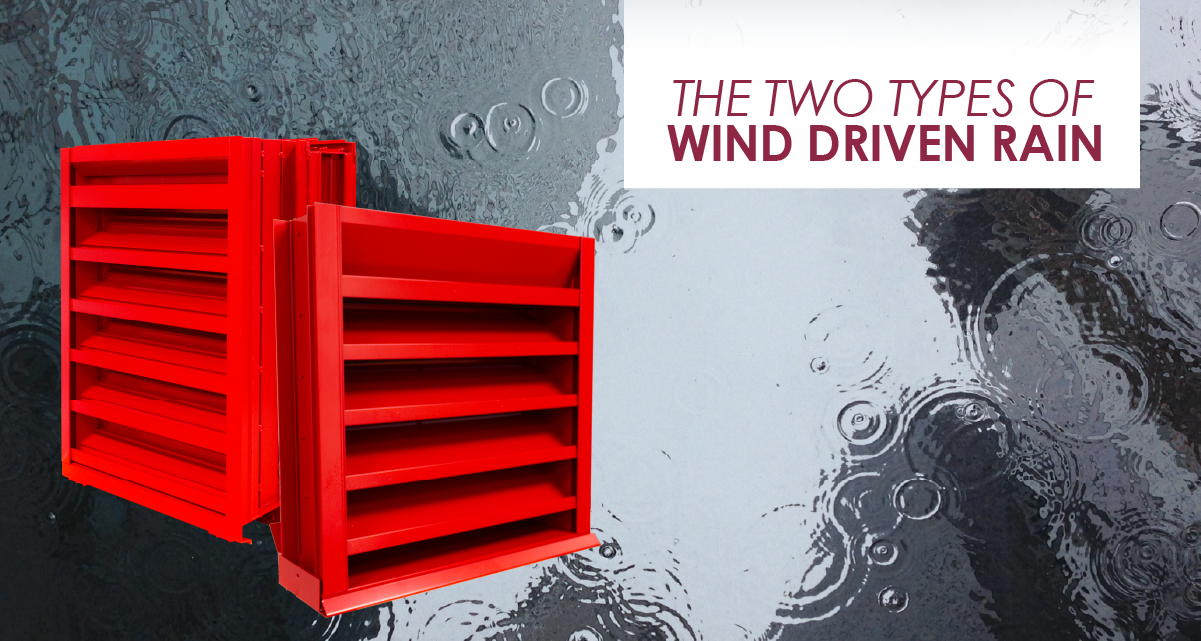Do you need a wind driven rain-rated louver or an AMCA 550-listed louver? There are two types of wind driven rain. Learn the difference with the MCDLG Newsstand.
If you are looking for severe weather louvers, then you are familiar with the term “wind driven rain”. During a storm, you can expect gusts of wind and heavy rain. A standard drainable louver can reject incoming rain up to a point, but the main issue will be wind blowing into the louver.

Manufacturers design and test wind-driven rain louvers for wind-driven rain. They often have chevron blades, which capture and block rain on the airstream as it passes through the louver.
In a sense, wind driven rain louvers are a step up in protection. Did you know there are two forms of wind driven rain?
Wind Driven Rain Testing
AMCA provides the standards for testing a louver’s capability to reject wind driven rain. There is the standard wind driven rain test, conducted on severe weather louvers. Louvers that complete this test receive a certified ratings seal for wind driven rain.
The seal only signifies that the louver completed the tests in an AMCA-approved laboratory. Manufacturers display the performance data from these tests on the louver’s submittal.
You will need to consult the louver’s wind driven rain data to determine if it works for your project. Check out this article for the full details on AMCA’s wind driven rain testing.

Here is a quick rundown of the wind driven rain test. Testers install the louver in an assembly that simulates severe weather, including heavy rain and fierce winds. A chamber behind the louver collects any water that passes through the louver. Testers measure the amount of water collected in this chamber at regular intervals and compare it to the total amount of water used during the test.
.webp?width=271&height=400&name=EA331VSL%20-%20Vertical%20Blade%20Storm%20Louver%20(Resize).webp) The louver will receive a letter grade, known as an effectiveness rating, based on the amount of water rejected.
The louver will receive a letter grade, known as an effectiveness rating, based on the amount of water rejected.
An effectiveness rating of Class A means that the louver rejected 99% or more of the incoming rain during that interval of the test. A highly effective, severe weather louver will have Class A ratings across all intervals of the test.
High Velocity Wind Driven Rain
There is also “high velocity wind driven rain” testing. You may have seen this requirement in projects near coastal regions or in high velocity hurricane zones.
AMCA reserves high velocity wind driven rain testing for hurricane louvers under AMCA 550. There are key differences in testing that set AMCA 550 apart from standard wind driven rain.
The maximum test speed will be 110 miles per hour, which is the maximum wind speed of a category 2 hurricane. AMCA 550 does not have effectiveness ratings. Instead, the louver must reject 99% or more of incoming water throughout the test.
If the louver fails to reject less than 99% at any point, the louver fails the high velocity wind driven rain test. If effectiveness ratings did apply, then a hurricane louver would need to get a Class A rating throughout the entire test to complete AMCA 550 testing.

Louvers that completed the test receive an AMCA listing label. This differs from an AMCA ratings seal. AMCA separates hurricane louvers into a listing program, which signifies that the louver has completed testing for AMCA 540, AMCA 550, or both.
Manufacturers do not display performance data for AMCA 550 testing on the louver’s submittal, because it is a pass or fail test. If the label is present on the submittal, then the louver has passed the test.
Which Type of Protection Do You Need?
It may seem obvious to choose one over the other. A louver tested to AMCA 550 would always provide the best protection against wind driven rain. While this is typically true, your decision will not be that easy.
Manufacturers build hurricane louvers to withstand extreme weather. They are generally larger and heavier than wind driven rain louvers. Therefore, they will need additional support at the installation site. You should only choose a hurricane louver if the requirements call for hurricane protection.

Water infiltration can cause water damage and reduce the indoor air quality of your building. For severe weather requirements, look for a louver rated for wind driven rain. Check for the AMCA certified ratings seal for wind driven rain, then review the louver’s test data on the submittal. This will help you determine if the louver will work for your project.
Louvers with vertical chevron blades often provide wind driven rain protection with minimal impact on the airflow. Vertical drain blades use gravity to drain rainwater to the sill quickly. You can choose to add a drain pan to help minimize backsplash.
You have options for wind driven rain protection, but you should understand those options. Wind driven rain testing is for severe weather protection, while high-velocity wind driven testing is for extreme weather and hurricane protection.
Always choose the louvers that meet your requirements. Remember to check the submittal for performance data.

Which requirement do you see more often: wind driven rain or AMCA 550? Let us know in the comment section. We want to hear from you!
Need louvers? Airline Louvers can build what you need. We offer stationary louvers for meeting a wide range of requirements, from basic airflow needs to hurricane requirements. Contact Airline Louvers today.
For more on louvers, check out these Newsstand articles:
- Drainable Louvers for Rainy Days
- The Condenser - Louver Style for Building Aesthetics
- AMCA Testing for Louvers - Water Penetration
.webp?width=91&height=70&name=MCDLG%20Logo%20(Resize).webp)





